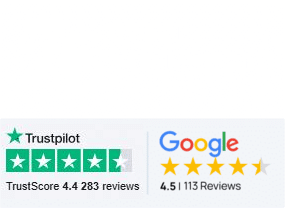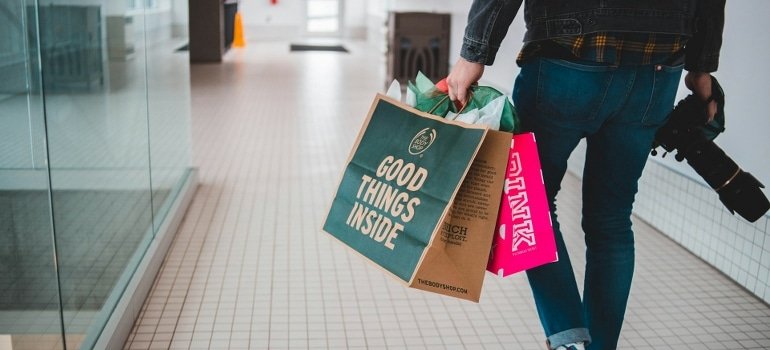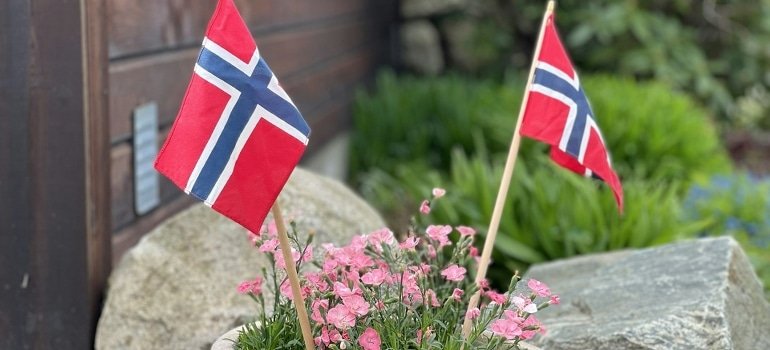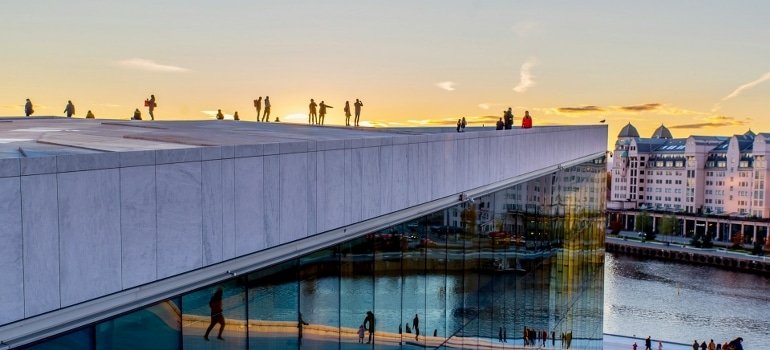Is Moving to Oslo Worth It? Here’s What Expats Say

Get a Free Moving Quote Now!
Start Your International Moving Journey





Oslo doesn’t scream for attention the way some capital cities do, but it pulls people in slowly and permanently. The Norwegian capital consistently ranks high for quality of life, safety, and happiness, which is why expats keep arriving despite the weather and cost. International movers say clients often choose Oslo after visiting once and realizing how calm and organized everyday life can be. You trade chaos for structure, and noise for nature. But is moving to Oslo really worth the price tag, the language hurdles, and the dark winters? Here’s what real expats say once they’ve made the leap.
What’s the Real Cost of Living—And Is It Worth It?
People moving to Oslo always ask the same question first: how expensive is it really? Moving to Norway means preparing for sticker shock. Rent eats up the biggest part of the budget. A one-bedroom in central Oslo now averages around 19,000 NOK ($1,800 USD) per month. Add another 2,000 to 3,500 NOK for electricity, water, and internet, depending on the season and provider. Grocery prices also hit hard. Milk is 23 NOK ($2.20 USD), bread is 35 NOK ($3.30 USD), and chicken breast runs about 135 NOK ($13 USD) per kilo. You can easily spend 4,000 to 5,500 NOK per person each month on groceries alone.

A standard meal at a mid-range restaurant for two people costs about 900 NOK ($85 USD). Alcohol is heavily taxed—expect to pay 100 NOK for a beer at a pub. But here’s the tradeoff: minimum wage isn’t a thing because most people earn well above it, with average salaries around 650,000 NOK per year ($61,000 USD). Taxes are high, yes, but you get public healthcare, good schools, generous parental leave, and clean, walkable neighborhoods. Daily life feels calm, efficient, and safe. In the end, most expats say it’s expensive—but worth every krone.
How Do You Handle the Long Winters and Lack of Sunlight?
Winters in Oslo can last from October to April, with the darkest months being November through January. International household goods movers warn new arrivals to prepare mentally, not just physically. In December, the sun rises at 9:20 a.m. and sets around 3 p.m.—and that’s on a clear day. Some expats report feeling tired, depressed, or out of sync until they adapt. But Norwegians have a word for this: “koselig,” meaning cozy and content. They lean into it.
Homes use warm lighting and lots of candles. People ski, skate, or walk even when it’s dark. You’ll see kids bundled up and playing outside in -5°C (23°F) weather because Norwegians believe there’s no bad weather, only bad clothing. Many expats invest in SAD lamps and vitamin D supplements. Some even plan short winter getaways to Spain or Portugal for a dose of sun. It’s hard, yes, but once you learn the rhythm, Oslo winters can feel peaceful instead of punishing.
What’s Work Culture Like and Can Expats Find Jobs?
Oslo’s job market isn’t closed, but it’s not wide open either. International movers in NYC say many expats struggle at first because the Norwegian job market values experience inside Norway. Networking is more important than flashy resumes. Also, many jobs still require fluency in Norwegian, even if your role is mostly in English. That said, industries like tech, engineering, academia, and oil and gas are more open to foreigners. If you land a job, you’ll notice the culture immediately.
There’s very little hierarchy. Managers expect you to speak your mind. Employees usually leave by 4 p.m., and no one answers emails over the weekend. Paid vacation starts at 25 days minimum, and work-life balance is not just encouraged—it’s built into the system. The job hunt may take longer than you expect, but once you’re in, most expats find the stability and flexibility incredibly refreshing.
How Hard Is It to Learn Norwegian—And Do You Really Need It?
Most people in Oslo speak excellent English, especially under 40. International movers in NJ confirm that newcomers can get by for years without learning Norwegian. But that doesn’t mean you should. While many companies operate in English, you’ll hit a wall socially and professionally if you don’t speak the language. Making local friends, reading official letters, and understanding your kid’s school documents all become easier with basic fluency.

Fortunately, Norway offers free or subsidized language classes to many immigrants, especially those with residency permits. Apps like Duolingo help but won’t get you to fluency. In-person classes, language cafés, and TV subtitles help build real-world skills. It’s a slow process, but even imperfect Norwegian goes a long way. You don’t need to be perfect—you just need to show that you’re trying. Locals appreciate the effort and open up faster when you meet them halfway.
How Competitive Is the Housing Market—And Where Do Expats Live?
Finding a place to live in Oslo takes persistence and fast reflexes. International piano movers say it’s one of the toughest parts of relocating. Demand is high, especially for rentals in popular neighborhoods near the city center. You’ll need three months’ rent upfront: one month for a security deposit and usually two months pre-paid rent. Apartments in Grünerløkka, Majorstuen, and Frogner go fast because they balance access to shops, parks, and transit. A two-bedroom in these areas ranges from 22,000 to 28,000 NOK per month ($2,100–$2,700 USD). Most leases are 12 months minimum and require a stable income and solid references.
Newcomers sometimes stay in temporary Airbnb rentals or company housing for the first few months until they secure a long-term lease. Landlords often respond only to those already in Oslo, so being physically present helps. The good news? Once you’re in, your rent typically includes heat, water, and maintenance—no surprise bills. The bad news? You’ll probably have to compete with 20 others for each listing, so act fast.
Is Oslo Really as Safe and Clean as They Say?
Yes, and it’s one of the first things newcomers notice. Fine art shipping services often highlight Oslo’s reputation for secure, efficient logistics—and that sense of order extends to daily life. Violent crime is rare. Most incidents involve theft from unlocked bikes or pickpocketing in busy tourist spots. Women feel safe walking alone at night. Kids walk to school alone starting at a young age.
The streets are clean, recycling is enforced, and people take pride in not littering. You’ll also notice that nothing feels rushed. Public transportation runs on time, cars stop for pedestrians, and neighbors greet each other in passing. Emergency services are quick to respond. Public spaces like parks, libraries, and sports halls are well-maintained and welcoming. Safety doesn’t feel like a privilege here—it’s just how life works.

Can Expats Access Healthcare and How Does It Work?
Once you register as a resident and get your Norwegian ID number (personnummer), you’re entitled to public healthcare. Container shipping timelines usually align with the 1–3 month window most expats face before getting full access. The system is funded through taxes and co-pays, which means most services are either free or affordable. A visit to a general practitioner costs about 160–250 NOK ($15–$24 USD), with an annual cap around 2,700 NOK. Once you hit that, everything else is free.
You choose your GP through an online portal, and appointments are usually available within a week. Specialists take longer. Emergency care is available to everyone, regardless of status. Dental care isn’t covered for adults, but prices are lower than in many other countries. Private insurance exists, but most people don’t need it unless they want faster access to specialists. Pharmacies are clean, well-stocked, and staffed by professionals who usually speak English. Overall, the system works smoothly, especially once you’re registered.
How Family-Friendly Is Oslo for Kids and Parents?
Raising a family in Oslo is surprisingly easy once you settle in. International movers say many of their clients move here specifically for the family benefits. Children as young as one year can enroll in barnehage (kindergarten), which costs around 3,000 NOK per month with subsidies available. Parental leave includes 49 weeks at full pay or 59 weeks at 80%, split between both parents. Schools are free, follow a national curriculum, and emphasize outdoor learning.
Kids spend time outside every day, even in winter. Healthcare for children is fully covered. Safety is high, and playgrounds are everywhere. Public transit includes discounts for children, and strollers are allowed onboard for free. Teenagers get free high school education and access to vocational training or university prep. Oslo also hosts dozens of child-friendly museums, sports clubs, and libraries. Families find it easy to make routines here that prioritize well-being, education, and time together.
How Close Is Nature—and Does Anyone Actually Use It?
Nature in Oslo isn’t a bonus—it’s part of daily life. International movers often point this out when comparing Oslo to other European capitals. You don’t drive to nature—you walk, bike, or take a tram. The city is surrounded by the Oslomarka forest, with marked hiking trails, cabins, and cross-country ski routes. It’s normal to leave work at 4 p.m. and go snowshoeing 30 minutes later. Summer weekends mean swimming in the fjord or grilling in parks.
You’ll find lakes like Sognsvann just 20 minutes from downtown by metro. People of all ages, from toddlers to retirees, prioritize time outdoors. It’s baked into the culture. Work breaks sometimes include group walks. School kids go on forest field trips. Oslo even has laws protecting public access to green areas. For many expats, this easy access to fresh air and water becomes one of their top reasons for staying.

Is It Easy or Hard to Build a Social Life in Oslo?
Socializing in Oslo takes time and effort. International movers in NJ say this surprises a lot of newcomers. Norwegians are polite but reserved. You won’t be invited to someone’s home after one coffee chat. But when friendships form, they tend to last. Most people build social lives through work, hobbies, or volunteer groups. Oslo has clubs for hiking, yoga, coding, cooking, and language exchange. Sports teams and music schools are open to adults, not just kids.
Bars and restaurants are quieter than in cities like London or New York, but that doesn’t mean people don’t go out—they just go out differently. You’ll often find social life centered around shared activities rather than loud parties. Once you break the surface, Norwegians are loyal and caring friends. You may not have dozens of acquaintances, but you’ll likely have a solid core group once you put in the time.
Is Moving to Oslo the Right Call? Here’s the Real Answer
If you’re still on the fence about moving to Oslo, here’s the honest takeaway: it’s not perfect, but it’s solid. You’ll face high prices, cultural differences, and long winters—but you’ll also gain stability, safety, and access to nature that’s hard to match in other capitals. Most expats who stick around don’t just tolerate life in Oslo—they grow to love it. The city rewards patience and practicality. You get efficient systems, clean streets, and a society that values balance over burnout. The adjustment takes effort, especially if you’re used to louder, faster places. But if you’re looking for a fresh start somewhere thoughtful, functional, and calm, then moving to Oslo could be the right call. Think about what you value most. If structure, peace, and long-term quality of life top your list, there’s a good chance this city is worth it—for you, too.
